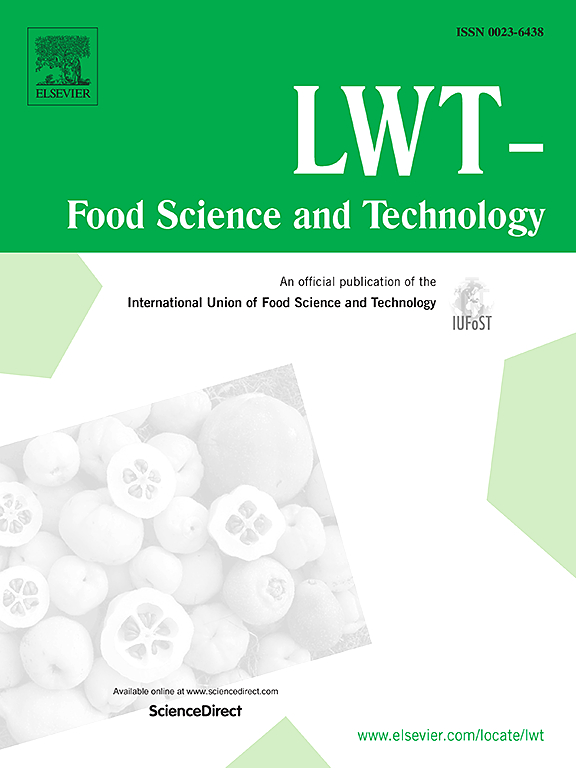透明质酸及其衍生物降低淀粉消化率的机制:糊化、多尺度结构和酶活性
IF 6.6
1区 农林科学
Q1 FOOD SCIENCE & TECHNOLOGY
引用次数: 0
摘要
已知非淀粉多糖可降低淀粉消化率并调节餐后血糖水平。透明质酸(HA)及其衍生物可能具有类似的作用,尽管其机制尚不清楚。为了阐明其淀粉消化率降低的分子机制,制备了HA自由基降解产物(HAO)和酶解产物(HAE)并对其进行了表征。分析发现,在HAO中,GlcA的还原端被氧化形成己烯二酸,而HAE则保持了饱和的多糖结构。研究了它们对小麦淀粉(WS)糊化、多尺度结构和酶活性的影响。结果表明,添加HA、HAO和HAE可使淀粉消化率分别降低至71.11±1.23%、61.78±0.67%和69.20±1.04%。透明质酸主要抑制淀粉糊化,促进更有序的分子和晶体结构,并阻止酶-淀粉相互作用。HAO和HAE通过与酶结合抑制酶活性。值得注意的是,与HAE(- 7.1和- 7.4 kcal/mol)相比,HAO对α-淀粉酶(- 7.3 kcal/mol)和淀粉葡糖苷酶(- 7.7 kcal/mol)表现出更强的亲和力,这可能是由于其羧基与酶之间形成了氢键。这表明直接靶向淀粉消化酶是影响淀粉消化率的更有效的方法。本文章由计算机程序翻译,如有差异,请以英文原文为准。

Insights into the mechanism of hyaluronic acid and its derivatives reducing starch digestibility: Gelatinization, multiscale structures, and enzyme activity
Non-starch polysaccharides are known to reduce starch digestibility and modulate postprandial blood glucose levels. Hyaluronic acid (HA) and its derivatives may exert similar effects, although their mechanisms remain unclear. To elucidate the molecular mechanism of their starch digestibility reduction, the HA radical degradation products (HAO) and enzymatic hydrolysates (HAE) were prepared and characterized. The analysis revealed that in HAO, the reducing end of GlcA was oxidized to form hexendioic acid, while HAE maintained a saturated polysaccharide structure. Their impacts on wheat starch (WS) gelatinization, multiscale structure, and enzyme activities were investigated. The results indicated that the addition of HA, HAO, and HAE reduced starch digestibility to 71.11 ± 1.23 %, 61.78 ± 0.67 %, and 69.20 ± 1.04 %, respectively. HA primarily inhibited starch gelatinization, promoted more ordered molecular and crystalline structures, and prevented enzyme-starch interactions. Enzyme activity was inhibited by HAO and HAE through binding to the enzyme. Notably, HAO exhibited a stronger affinity for α-amylase (−7.3 kcal/mol) and amyloglucosidase (−7.7 kcal/mol) compared to HAE (−7.1 and −7.4 kcal/mol), likely due to hydrogen bonds formed between its carboxyl groups and the enzymes. This suggests that directly targeting starch-digesting enzymes is a more effective approach to influence starch digestibility.
求助全文
通过发布文献求助,成功后即可免费获取论文全文。
去求助
来源期刊

LWT - Food Science and Technology
工程技术-食品科技
CiteScore
11.80
自引率
6.70%
发文量
1724
审稿时长
65 days
期刊介绍:
LWT - Food Science and Technology is an international journal that publishes innovative papers in the fields of food chemistry, biochemistry, microbiology, technology and nutrition. The work described should be innovative either in the approach or in the methods used. The significance of the results either for the science community or for the food industry must also be specified. Contributions written in English are welcomed in the form of review articles, short reviews, research papers, and research notes. Papers featuring animal trials and cell cultures are outside the scope of the journal and will not be considered for publication.
 求助内容:
求助内容: 应助结果提醒方式:
应助结果提醒方式:


